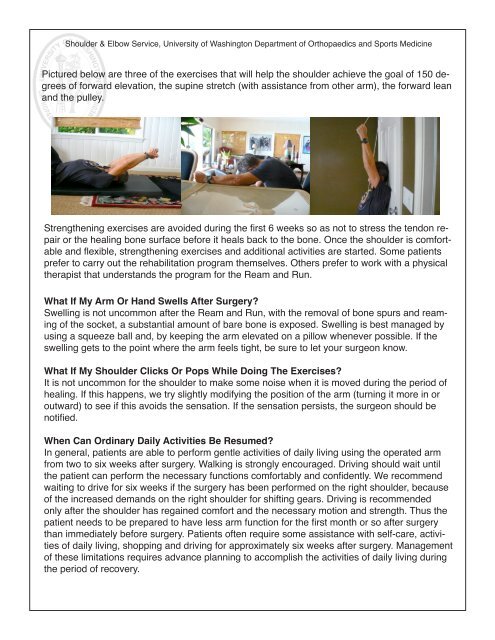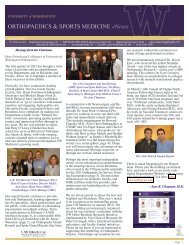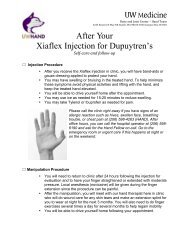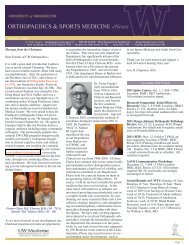Ream and Run for Shoulder Arthritis: Conservative Reconstructive ...
Ream and Run for Shoulder Arthritis: Conservative Reconstructive ...
Ream and Run for Shoulder Arthritis: Conservative Reconstructive ...
Create successful ePaper yourself
Turn your PDF publications into a flip-book with our unique Google optimized e-Paper software.
<strong>Shoulder</strong> & Elbow Service, University of Washington Department of Orthopaedics <strong>and</strong> Sports Medicine<br />
Pictured below are three of the exercises that will help the shoulder achieve the goal of 150 degrees<br />
of <strong>for</strong>ward elevation, the supine stretch (with assistance from other arm), the <strong>for</strong>ward lean<br />
<strong>and</strong> the pulley.<br />
<br />
<br />
Strengthening exercises are avoided during the first 6 weeks so as not to stress the tendon repair<br />
or the healing bone surface be<strong>for</strong>e it heals back to the bone. Once the shoulder is com<strong>for</strong>table<br />
<strong>and</strong> flexible, strengthening exercises <strong>and</strong> additional activities are started. Some patients<br />
prefer to carry out the rehabilitation program themselves. Others prefer to work with a physical<br />
therapist that underst<strong>and</strong>s the program <strong>for</strong> the <strong>Ream</strong> <strong>and</strong> <strong>Run</strong>.<br />
What If My Arm Or H<strong>and</strong> Swells After Surgery?<br />
Swelling is not uncommon after the <strong>Ream</strong> <strong>and</strong> <strong>Run</strong>, with the removal of bone spurs <strong>and</strong> reaming<br />
of the socket, a substantial amount of bare bone is exposed. Swelling is best managed by<br />
using a squeeze ball <strong>and</strong>, by keeping the arm elevated on a pillow whenever possible. If the<br />
swelling gets to the point where the arm feels tight, be sure to let your surgeon know.<br />
What If My <strong>Shoulder</strong> Clicks Or Pops While Doing The Exercises?<br />
It is not uncommon <strong>for</strong> the shoulder to make some noise when it is moved during the period of<br />
healing. If this happens, we try slightly modifying the position of the arm (turning it more in or<br />
outward) to see if this avoids the sensation. If the sensation persists, the surgeon should be<br />
notified.<br />
When Can Ordinary Daily Activities Be Resumed?<br />
In general, patients are able to per<strong>for</strong>m gentle activities of daily living using the operated arm<br />
from two to six weeks after surgery. Walking is strongly encouraged. Driving should wait until<br />
the patient can per<strong>for</strong>m the necessary functions com<strong>for</strong>tably <strong>and</strong> confidently. We recommend<br />
waiting to drive <strong>for</strong> six weeks if the surgery has been per<strong>for</strong>med on the right shoulder, because<br />
of the increased dem<strong>and</strong>s on the right shoulder <strong>for</strong> shifting gears. Driving is recommended<br />
only after the shoulder has regained com<strong>for</strong>t <strong>and</strong> the necessary motion <strong>and</strong> strength. Thus the<br />
patient needs to be prepared to have less arm function <strong>for</strong> the first month or so after surgery<br />
than immediately be<strong>for</strong>e surgery. Patients often require some assistance with self-care, activities<br />
of daily living, shopping <strong>and</strong> driving <strong>for</strong> approximately six weeks after surgery. Management<br />
of these limitations requires advance planning to accomplish the activities of daily living during<br />
the period of recovery.















